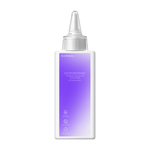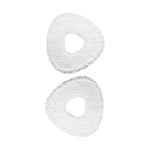Keeping your robot vacuum filter clean is key to maintaining strong suction, efficient dust pickup, and healthier indoor air. Whether you use a washable foam filter or a HEPA filter, regular cleaning and timely replacement can significantly improve your vacuum’s performance and extend its lifespan.
In this guide, you'll learn exactly how to clean a robot vacuum filter with easy step-by-step instructions. We'll also cover how often to clean it, when to replace it, and how to tell different filter types apart. You'll find out which filters are washable, how to handle common issues like clogs or odors, and which maintenance habits make the biggest difference.
Proper filter care reduces battery strain, helps your vacuum run quieter, and ensures your device works effectively in high-dust or pet-heavy environments. Let’s get started with practical tips to keep your robot vacuum in top condition.
How to Clean a Robot Vacuum Filter: Step-by-Step Guide
Cleaning your robot vacuum filter is essential to keep it running efficiently. Here’s a comprehensive guide to help you clean the filter on your robot vacuum.

-
Turn Off and Unplug: Before starting, turn off your robot vacuum and unplug it from the charging dock. This ensures your safety and prevents any electrical issues during cleaning.
-
Remove the Dustbin: Take out the dustbin from your robot vacuum. This is usually done by pressing a release button or sliding the dustbin out. Check your user manual if you’re unsure how to remove the dustbin.
-
Locate the Filter: Open the dustbin and locate the filter. It’s usually placed inside the dustbin or attached to a specific compartment. Some models have multiple filters (e.g., primary and HEPA filters), so make sure you clean all of them.
-
Remove the Filter: Gently remove the filter from its housing. Depending on the model, you may need to press a latch or slide it out. Handle the filter carefully to avoid damaging it.
-
Tap to Remove Loose Dirt: Take the filter outside and gently tap it against a hard surface to dislodge loose dust and debris. Do this over a trash can or in a well-ventilated area to avoid spreading dust indoors.
-
Use a Soft Brush: Use a soft-bristled brush to gently clean the filter, removing finer particles without damaging it. Avoid using hard brushes or sharp tools, as they can damage the filter material.
-
Rinse the Filter (If Applicable): If your filter is washable, rinse it under lukewarm water until the water runs clear. Do not use soap or harsh chemicals, as they can damage the filter. Let the filter air dry completely before reinserting it.
-
Dry the Filter: Shake off any excess water and place the filter in a well-ventilated area to air dry. Ensure the filter is completely dry before reinserting it to prevent mold or mildew growth.
-
Inspect the Filter: Check the filter for any signs of damage or wear. If the filter is torn or heavily worn, it’s time to replace it. Regularly inspecting the filter helps maintain optimal performance and prevents damage to your vacuum.
-
Reinsert the Filter: Once the filter is completely dry, carefully place it back into the filter compartment. Make sure the filter is properly seated to ensure optimal performance.
-
Reassemble the Dustbin: Place the dustbin back into the robot vacuum, ensuring it clicks into place. Double-check that the dustbin is securely attached to avoid any issues during operation.
-
Test Your Robot: Turn on your robot vacuum and perform a test run to make sure everything is working correctly. If you notice reduced suction power, double-check that the filter is installed correctly.
How Often Should You Clean Your Robot Vacuum Filter?
Generally, once a week. For homes with pets, allergies, or dusty environments, you may need to clean it 2-3 times a week. Regular cleaning ensures your vacuum maintains strong suction power and prevents dust buildup. Additionally, replace the filter every 3-6 months (or after 120 hours of use for Narwal models) to keep your robot running efficiently. If your vacuum has a companion app, check the filter status for replacement reminders. Keeping your filter clean and fresh means a cleaner home and a longer-lasting vacuum!
When to Replace Your Robot Vacuum Filter for Best Performance
Look out for the following signs that indicate it's time to replace the filter:
-
Noticeable drop in suction power even after cleaning
-
Strange or persistent odors coming from the vacuum
-
Visible wear, tearing, or discoloration of the filter
-
Filter looks clogged or can’t return to its original state after tapping or brushing
-
You have cleaned the filter many times and it no longer performs as expected
As a general rule, most robot vacuum filters should be replaced every 3 to 6 months. If you live in a home with pets, allergies, or heavy dust, consider replacing it more frequently.
For Narwal users, refer to your model’s user manual to find compatible replacement filters and instructions.
Types of Robot Vacuum Filters and How to Maintain Them
Robot vacuums generally come with three types of filters.
-
HEPA Filters: The design of high-efficiency particulate Air (HEPA) filters can trap tiny particles.
-
Foam Filters: Often used as a first layer to catch larger debris.
-
Cartridge Filters: These are versatile and efficient filters.
Each filter type has specific maintenance needs. Check your robot vacuum's manual for detailed instructions on cleaning and replacement.
|
Filter Type |
Maintenance Frequency |
Cleaning Method |
Replacement Interval |
|
HEPA Filters |
Weekly |
Tap out dust, non-washable |
Every 3-6 months |
|
Foam Filters |
Weekly |
Rinse with water, air-dry |
Every 3-6 months |
|
Cartridge Filters |
Monthly |
Tap out dust, sometimes washable |
Every 3-6 months |
Cartridge filters refer to the shape or assembly, not the material. Some use HEPA media, while others may contain washable foam. Always follow manufacturer instructions to avoid damaging the filter.
Are Robot Vacuum Filters Washable?
Some robot vacuum filters can be washed, but not all. Whether you can rinse a filter with water depends on its type.
-
Foam filters are usually washable. You can rinse them under lukewarm water and let them dry completely before reuse.
-
HEPA filters are generally not washable unless clearly labeled. Washing them can damage the fine filter material and reduce their effectiveness.
-
Cartridge filters vary by brand and design. Some may allow rinsing, while others require dry cleaning or full replacement.
Always check your vacuum’s manual or the filter label before washing. Cleaning filters the wrong way can reduce suction power or shorten their lifespan. Proper maintenance improves vacuum performance and helps keep your indoor air clean.
Troubleshooting Robot Vacuum Filter Issues
Even with regular maintenance, you might encounter a few issues with your robot vacuum filter. Here’s a detailed guide to help you address these problems:
-
Loss of Suction: If your robot vacuum loses suction, check the filter for blockages caused by dust, debris, or pet hair. Clean the filter thoroughly or replace it if necessary. Also, inspect the dustbin and brush roll for clogs, as they can also cause suction issues.
-
Unusual Noises: Unusual sounds may indicate a blocked filter or foreign objects stuck in the vacuum. Remove the filter and inspect it for damage or blockages. Clean or replace it as needed. Additionally, check the brush roll and wheels for tangled hair or debris, as these can also cause noise.
-
Persistent Odors or Mold Growth: Lingering smells or musty odors often mean the filter is saturated with dirt or mold. Soak the filter in a solution of water and vinegar (1:1 ratio) or baking soda for a few hours, then rinse and let it dry completely. If the odor persists, replace the filter, as it may be too worn out to clean effectively.
-
Tough Stains or Residue: For tough stains, use a mild detergent or soap with a soft-bristled brush to gently scrub the filter. Rinse thoroughly with water and let it air dry completely before reinserting. Avoid using harsh chemicals, as they can damage the filter material.
-
Filter Damage or Excessive Wear: If the filter has tears, holes, thinning material, or frayed edges, replace it immediately. Check your user manual for the correct replacement filter and installation instructions. Regularly inspect the filter for signs of wear to avoid performance issues.
-
Improper Drying: If the filter remains damp after cleaning, use a hairdryer on a cool setting or place it in a well-ventilated area for a few hours to dry completely. Never reinsert a damp filter, as it can lead to mold growth and reduce suction power.
-
Filter Not Fitting Properly: If the filter doesn’t fit securely, check for damage or deformation. Replace the filter if necessary, and ensure it’s installed according to the user manual. A loose filter can reduce suction power and allow dust to bypass the filtration system.
-
Reduced Cleaning Performance: If your robot vacuum isn’t cleaning as effectively, check the filter for clogs or damage. Clean or replace it, and also inspect the dustbin, brush roll, and sensors for issues. Regular maintenance of all components ensures optimal performance.
Can I use a hand vacuum to clean the filter?
Yes. You can use a hand vacuum to remove loose dirt from non-washable filters. Be gentle to avoid damage.
What if my filter has a foul odor?
You can rinse washable filters with water. If the smell persists, it might be time to replace the filter.
Can I wash a HEPA filter?
No, the design of HEPA filters can trap fine particles. So, never wash them as water can damage them.
How Do I Know If My Filter Needs Cleaning or Replacing?
If your filter has visible dust or stains but no damage, it likely just needs cleaning. However, if the filter has odors, mold, tears, or thinning material, or if your vacuum’s performance has noticeably declined, it’s time to replace it. As a general rule, if the filter cannot be thoroughly cleaned or is affecting the vacuum’s performance, it’s best to replace it.
What Should I Do If My Filter Is Damaged?
If your filter has tears, holes, or thinning material, replace it immediately. Using a damaged filter can reduce your vacuum’s performance and may allow dust to enter the motor, causing further damage. Always keep a spare filter on hand for quick replacements.
What If the Filter Doesn’t Fit Properly After Installation?
If the filter doesn’t fit properly, first check if it’s deformed or damaged. If so, replace it with a new one. Make sure the filter is installed correctly according to the user manual. If the problem persists, the filter compartment might be damaged, and you should contact customer support for assistance.
Keep Your Robot Vacuum Filter in Top Shape for a Cleaner Home
Proper filter care is essential to keep your robot vacuum running at full performance. A clean filter ensures stronger suction, better dust capture, and healthier air in your home. Whether you're using a washable foam filter or a non-washable HEPA filter, following the right maintenance schedule will extend your vacuum’s lifespan and save you from unnecessary repairs or early replacements.
Staying on top of cleaning and replacing your filter also means your robot vacuum can keep up with everyday messes—especially in homes with pets, kids, or allergies.
Ready to experience effortless cleaning with long-lasting results? Visit Narwal Australia to explore smart robot vacuums designed for superior performance and low-maintenance living. Our latest models feature powerful filtration systems and intuitive alerts, so you never have to guess when it’s time to clean or replace your filter.
Your cleaner, smarter home starts with one simple habit—keeping your vacuum filter in top condition.























































